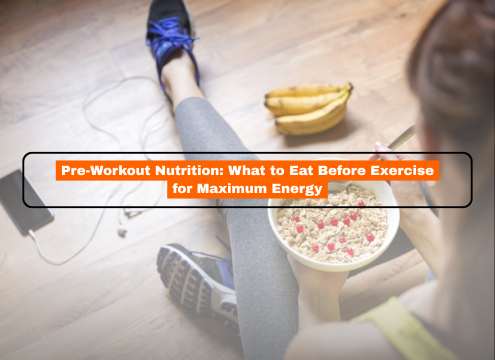When it comes to losing weight, most people automatically think: run more, sweat more, burn more calories. But is cardio truly king in the world of weight loss? Or is strength training the underrated hero?
If you’ve been confused by conflicting advice, you’re not alone.
Let’s break down the facts, compare the benefits of both, and uncover the best strategy for sustainable fat loss and a healthier, stronger body.
🔥 The Basics of Weight Loss
Before we dive into cardio vs. strength, here’s a quick science refresher:
Weight loss = Calories Out > Calories In
To lose weight, you must be in a caloric deficit—burning more calories than you consume.
But how you create that deficit, and more importantly, how you maintain your results, depends on more than just cardio sessions or protein shakes.
Let’s now understand how both cardio and strength training impact this equation.
🏃♂️ Cardio: The Calorie Torcher
💡 Any action that raises your heart rate and respiration is considered cardiovascular or aerobic exercise. Common examples include:
- Running or jogging
- Cycling
- Swimming
- Dancing
- Brisk walking
- High-intensity interval training (HIIT)
✅ Benefits for Weight Loss:
- Burns More Calories During the Workout
- Strength training burns less calories each session than cardio.
- Example: A 60-kg person can burn ~300–500 calories with 45 minutes of moderate-intensity cardio.
- Quick Fat Burn
- especially successful at reducing body fat in the near term when combined with a diet low in calories.
- Improves Heart Health and Endurance
- Reduces the risk of cardiovascular disease.
- Supports stamina and aerobic capacity.
- Mood Boost
- Cardio increases endorphins—natural mood enhancers that also curb emotional eating.
❌ Limitations of Cardio:
- Doesn’t build much lean muscle mass
- Excessive cardio can lead to muscle loss if not balanced with resistance training
- Calorie burn stops after the workout ends (minimal “afterburn effect”)
🏋️♀️ Strength Training: The Metabolism Booster
💡 What it is: Also known as resistance or weight training, strength training involves using resistance (like dumbbells, resistance bands, or body weight) to build muscle.
✅ Benefits for Weight Loss:
- Builds Lean Muscle
- Muscle is metabolically active—it burns calories even when you’re at rest.
- Your resting metabolic rate (RMR) increases as your muscle mass increases.
- Increases Post-Workout Calorie Burn
- The “afterburn” effect of strength training is caused by excess post-exercise oxygen consumption, or EPOC.
- Hours after your workout is over, your body still burning calories.
- Improves Body Composition
- You might not see a huge drop in the scale, but you’ll lose fat and gain muscle.
- This leads to a toned, defined look—not just a smaller body.
- Preserves Muscle During Weight Loss
- Weight loss without strength training often results in muscle loss.
- Resistance training helps retain lean mass, making your weight loss more sustainable.
- Prevents Weight Regain
- More muscle = higher metabolism = better long-term weight maintenance.
❌ Limitations of Strength Training:
- Calorie burn during the workout is lower compared to cardio
- Requires cautious progress and appropriate form in order to prevent damage.
- Results may appear slower on the scale
⚖️ Head-to-Head Comparison: Cardio vs. Strength for Fat Loss
| Feature | Cardio | Strength Training |
| Calorie Burn (During) | High | Moderate |
| Calorie Burn (After) | Low | High (EPOC effect) |
| Muscle Gain | Minimal | Significant |
| Metabolic Boost | Temporary | Long-lasting |
| Heart Health | Excellent | Good |
| Fat Loss Support | Short-term | Long-term |
| Weight Maintenance | Moderate | Strong |
| Body Shaping | Minimal | High |
✅ Best Approach: Combine Both
To get the best results, combine strength and aerobic training; it’s not a choice between the two.
Here’s why:
- Cardio helps create the calorie deficit needed to lose fat.
- Strength training guarantees that fat, not muscle, will be the source of your weight loss.
- Together, they support heart health, metabolic health, strength, endurance, and mental well-being.
🧠 Science Says:
Numerous studies show that combining cardio with resistance training leads to:
- Greater fat loss
- Better body composition
- Improved metabolic rate
- Better blood sugar regulation
One study published in Obesity found that participants who combined aerobic and resistance training lost more fat and gained more lean muscle compared to those who did either alone.
🗓️ How to Structure Your Weekly Routine
💪 Goal: Fat Loss + Muscle Retention + Endurance
| Day | Activity |
| Monday | Strength Training (Full Body) |
| Tuesday | 30–45 min Cardio (HIIT or steady state) |
| Wednesday | Active Recovery (Yoga, Walk) |
| Thursday | Strength Training (Upper/Lower Split) |
| Friday | 30–45 min Cardio |
| Saturday | Full Body Strength + Short HIIT |
| Sunday | Rest or Light Stretching |
Pro Tip: Focus on compound movements (like squats, lunges, deadlifts, pushups) that burn more calories and engage multiple muscles.
🍎 The Missing Piece: Clean Eating
You can’t out-train a poor diet.
Whether you run 10k a day or lift heavy weights, weight loss comes down to:
- Consistent calorie control
- Balanced macronutrient intake (protein, carbs, fats)
- Whole, unprocessed foods
Fuel your body with the right nutrients to see visible changes in energy, performance, and physique.
🧩 Mindset Matters Too
It’s not about chasing numbers on the scale or torturing your body. True transformation comes from:
- Moving your body regularly
- Fueling it with intention
- Respecting recovery
- Being consistent, not extreme
🏁 Final Thoughts: What’s the Verdict?
So, which is better for losing weight: strength training or cardio?
👉 Cardio helps you burn more calories now.
👉 Strength exercise increases your calorie burn over time.
If your goal is:
- Quick calorie burn: Add cardio
- Long-term fat loss: Prioritize strength
- Sustainable transformation: Combine both
The sweet spot = 3–4 days of strength + 2–3 days of cardio + smart nutrition.
Because it’s not just about losing weight—it’s about losing fat, building confidence, and living stronger.
5 Fitness Mistakes That Could Be Slowing Down Your Progress (And How to Fix Them)
Getting into fitness is exciting—but sticking with it and seeing real results? That takes more than just willpower. Even the most motivated people unknowingly make mistakes that sabotage their progress.
The truth is: you could be working out consistently and still not seeing results. Frustrating, right?
Let’s uncover 5 common fitness mistakes that silently stall your transformation—and more importantly, how to fix them so you can train smarter, feel stronger, and see results faster.
⚠️ 1. Skipping Warm-Ups and Cool-Downs
❌ The Mistake:
Jumping straight into intense workouts without a warm-up or skipping stretches afterward might seem like a time-saver. But it’s one of the fastest ways to invite injury and reduce workout quality.
💥 Why It Matters:
- Cold muscles are more prone to injury.
- Blood flow, mobility, and mental clarity are all enhanced by warming up.
- Cooling down helps reduce muscle soreness and supports recovery.
✅ Fix It:
- Warm-Up (5–10 mins): Include dynamic stretches like leg swings, arm circles, or light cardio (jogging, jumping jacks) to prep your body.
- Cool-Down (5–10 mins): Do static stretches targeting muscles used during your workout—think hamstrings, quads, chest, and back.
- Bonus: Deep breathing during cool-down can calm the nervous system and promote faster recovery.
Tip: Think of warm-up as turning the ignition and cool-down as applying the brakes—both are essential for a smooth fitness journey.
😴 2. Overtraining Without Enough Recovery
❌ The Mistake:
“More is better” is a common mindset, especially in the early stages. But overtraining—working out intensely every day without giving your body a break—can backfire.
💥 Why It Matters:
- Muscles do not grow and mend during exercise.
- Chronic fatigue, mood swings, injuries, sleep issues, and poor performance can all be signs of overtraining.
- Lack of recovery can spike cortisol levels, increasing belly fat and slowing metabolism.
✅ Fix It:
- Schedule rest days: At least 1–2 full rest days per week.
- Sleep 7–9 hours every night. This is when your body repairs most efficiently.
- Rotate workout intensity: Mix hard days with active recovery (walking, yoga, light stretching).
- Listen to your body. Soreness is normal, but persistent pain or fatigue is not.
Remember: Progress comes from a balance of challenge + recovery. The rest is equally as vital as the reps, so don’t overlook it.
🍕 3. Poor Nutrition Choices
❌ The Mistake:
You train hard but still indulge in processed foods, skip meals, or under-eat thinking it’ll speed up weight loss. Unfortunately, a poor diet cannot be out-trained by any amount of activity.
💥 Why It Matters:
- Food is fuel. Poor nutrition leads to low energy, muscle breakdown, and slower recovery.
- Under-eating can push your body into starvation mode, slowing metabolism and making fat loss harder.
- Excess junk food adds empty calories without supporting muscle repair or satiety.
✅ Fix It:
- Prioritize whole, nutrient-dense foods: complex carbs (sweet potatoes, oats), lean proteins (eggs, tofu, legumes), healthy fats (nuts, seeds, olive oil).
- Eat enough protein—aim for 1.2–2g/kg of body weight to support muscle growth.
- Don’t skip meals. Instead, fuel around your workouts—carbs for energy pre-workout, protein post-workout for recovery.
- Stay hydrated: even mild dehydration reduces performance.
Rule of thumb: You’re not just eating for weight—you’re eating to train harder, recover faster, and feel better.
🏋️♀️ 4. Neglecting Strength Training
❌ The Mistake:
Only doing cardio because it burns calories faster or fearing that lifting weights will make you bulky. This myth keeps many from reaching their potential.
💥 Why It Matters:
- Gaining lean muscle through strength training raises your resting metabolic rate, which means you burn more calories throughout the day.
- It helps you avoid age-related muscle loss, tones your body, and enhances your posture.
- Cardio burns calories today, but muscle burns calories forever.
✅ Fix It:
- Include strength training 3–4 times a week. Concentrate on complex exercises such as push-ups, rows, deadlifts, and squats.
- Don’t fear weights. You won’t bulk up overnight—it takes time, and muscle is key to a fit, toned body.
- Use progressive overload—gradually increase weight, reps, or intensity to keep challenging your muscles.
Bonus Tip: Strength training also helps manage blood sugar, improves bone density, and boosts confidence. It’s a win-win-win.
📉 5. Lack of Consistency or Progress Tracking
❌ The Mistake:
Expecting quick results, not keeping track of your food or exercise, and working out irregularly. Fitness is a long game, and progress doesn’t always show up on the scale.
💥 Why It Matters:
- Sporadic workouts or vague goals make it hard to measure improvement.
- Without tracking, you don’t know what’s working—or what’s not.
- Consistency builds momentum and habits that compound over time.
✅ Fix It
- Set clear, realistic goals (e.g., “work out 4x/week” or “lose 2kg/month”).
- Track workouts: Log weights, sets, reps, or use fitness apps to measure progress.
- Monitor food: Use a food journal or app to stay mindful of nutrition.
- Celebrate non-scale victories: better energy, improved sleep, looser clothes, mood boosts.
Golden rule: Small efforts done consistently trump big efforts done occasionally.
💬 Bonus Mistake: Doing It Alone
Trying to figure out everything on your own can be overwhelming—and lonely.
✅ Fix It:
- Hire a coach, join a fitness group, or find an accountability partner.
- Community and support keep you motivated, informed, and on track.
💡 Final Thoughts: Train Smart, Not Just Hard
The gym isn’t just a place to burn calories—it’s a space to build habits, confidence, and long-term health.
Therefore, don’t give up if your growth has plateaued. Rather, check in:
- Are you warming up and cooling down properly?
- Are you letting your body recover?
- Are your food choices helping or hurting?
- Are you lifting weights consistently?
- Are you tracking your progress or just guessing?
When you address these small but mighty mistakes, you unlock the ability to train with purpose and progress with power.
✅ Summary: 5 Mistakes and Their Fixes
| Mistake | Fix |
| Skipping Warm-Ups & Cool-Downs | Add dynamic warm-ups and static stretching |
| Overtraining | Schedule rest days and get quality sleep |
| Poor Nutrition | Eat whole foods and fuel your workouts right |
| Skipping Strength Training | Add resistance workouts 3–4x/week |
| Inconsistency | Track progress and stay consistent with clear goals |
🔥 Closing Line:
Train smart, eat right, and recover well—because in the end, consistency beats intensity, every time.





